|
|
of Twin Swamps Nature Preserve |
|
| ||
|
|
|
|
|
|
|
On the Net: A Way to Learn About Twin Swamps This Is How I've Arranged the Photos
|
|
|
|
|
Some visitors to the Twin Swamps Nature Preserve are surprised by how little there is to see when they arrive at the small parking lot. Farm fields lie to the east. To the west is an unmowed field of reddish-brown broom sedge. Tall trees border the field, and there's no sign of a swamp anywhere. |
| |||
|
But an easy trail takes you across the grassy field, which is a dry place that fills with goldenrod and aster in the fall. In the spring, it contains a smattering of small flowers, including yellow wood sorrel, tiny pink geraniums, and blue Venus's looking-glass. The trail, which follows a shallow slope to the dark woods, is often marked with the tracks and occasionally the droppings of deer, raccoon and either coyote or somebody's dog. |
|
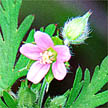 |
| |
|
At the entrance to the woods, the terrain changes dramatically, from dry and dusty to low and mucky. A wooden box on a post greets hikers who can sign a register and pick up a well-illustrated brochure that describes the preserve. Please sign the register. Indiana's Department of Natural Resources needs to know that its sites are being used. To sign the register, however, you're likely to be standing in a couple of inches of water, which is a good hint of what lies ahead. The first part of the Twin Swamps trail is not easy. The mud is thick and gloppy. Parts of the trail may be flooded, especially in the spring and early summer. It's a good idea to wear waterproof boots or, at the very least, decide ahead of time that you won't mind getting your feet wet. The DNR has placed some much-needed lengths of boardwalk at low points along the trail, but these sometimes come up short. Poison ivy grows profusely on both sides of the trail and on vines that climb many of the trees. Every few years, the DNR conducts a controlled burn that knocks the poison ivy back, but it's still there in abundance. Until May, the first half of the trail is notably devoid of wildflowers. While drier, upland forests around Southern Indiana abound in impressive stands of wildflowers throughout March, the cool, soggy bottomlands at Twin Swamps do not. A hiker may walk at least half a mile before spotting the first bloom, which inevitably is found just past a certain fallen tree that is thick with fungus. |
| |||
|
At this point, a casual observer might not notice that the trail is rising, but rise it does, and as it rises it becomes drier. This is where the first flowers of spring are found. Spring beauty, rue anemone, cut-leaved toothwort and smooth yellow violets will dot the forest floor. These pretty little flowers send out blooms as soon as they can to take advantage of the sun, before the woods fill with shade. The umbrella-like mayapple will also be seen, sometimes in thick patches, though it won't be ready to bloom for a couple of weeks. |
|
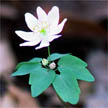 |
| |
|
The trail rises gently until it branches. Immediately ahead is the cypress swamp. To the left, a second trail heads for the other swamp, the overcup oak slough. But nestled in the wedge of land between the two trails is a large stand of Virginia bluebells, a trumpet-shaped flower of a striking soft blue. At their peak, in the middle two weeks of April, the bluebells make for a fantastic display. They took my breath away the first time I saw them. They're quite a find after a difficult hike through half-a-mile of muck. From the bluebells, the trail drops down to a boardwalk that reaches into the bald cypress swamp, which is the focal point of Twin Swamps. The boardwalk extends about 300 feet across dark shallow water. At the end of the walk, a few steps rise to a platform -- the end of the trail -- where hikers can gather strength, swat mosquitos and absorb the ambience. |
| |||
|
Here, the bald cypress trees rise high into the sky. At water level, the trees display their classic spreading base and their unusual "knees," formed by a sharp upward bend in their roots. A hiker can brush the inviting, soft needles of the branches. Botanist Mary Wharton discusses the bald cypress in Trees & Shrubs of Kentucky. Kentucky, of course, is only about three miles from Twin Swamps, due south and across the Ohio River: |
|
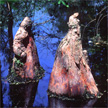 |
| |
|
This denizen of the deep swamp forests of the Atlantic and Gulf Coastal Plains and the Mississippi Embayment is at home in Kentucky only along the Mississippi River, the lower Ohio and Green rivers, and their immediate tributaries. ... The few remaining cypress swamps in Kentucky should be protected as ecological museums. [T]he species deserves respect as one of the few living representatives of an ancient family that includes also the redwoods and sequoias of the West. Millions of years ago, ... members of this family were numerous and spread throughout the northern hemisphere. Now most are extinct ... The other prominent tree that thrives in the water is the swamp cottonwood. This tree, which in late spring drops its fluffy white seed on the water like snow, is easily seen from the boardwalk. Look for its broad, almost heart-shaped leaf. By the end of May duckweed will cover the dark water, creating a green carpet that's soothing to the eye. Early in the season, a few yellow water buttercups poke up out of the water on their stiff stalks. Later, at the edge of the swamp, lizard's tail sends up its long, slender, curving white flower. In deeper water, eight-foot-tall buttonbush produces its odd globular flower. It's not unusual for a quiet hiker to scare up a great blue heron from the branches of the trees or from the boardwalk itself. With a startled squawk, they sail off laboriously on their big wings, sometimes settling not too far away where they can be easily observed. |
| |||
|
The tall trees may abound with warblers and woodpeckers. It's especially easy to spot the colorful prothonotary warbler, a gold and green bird who seems particularly at home in wooded swamps and who nests among the buttonbush. Also common is the blue-gray gnatcatcher, a mosquito eater who has no trouble finding a snack here. |
|
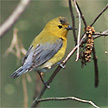 |
| |
|
The prothonotary's appearance in the swamps of the Wabash has been well-documented. Arthur Cleveland Bent's Life History of North American Wood Warblers suggests that this bird should actually be called the "golden swamp warbler," noting that it is "essentially a bird of the ... swampy river bottoms and low-lying woods." Remarkably, Bent then adds, "Perhaps this warbler abounds more than anywhere else in the valley of the lower Wabash," where William Brewster (1878) found it to be: one of the most abundant and characteristic species. ... Among the button-bushes that fringed the ... peculiar long narrow ponds scattered ... over the heavily timbered bottoms of the Wabash and White Rivers, they ... congregated in astonishing numbers, and early in May were breeding almost in colonies. ... [T]he song of the male heard from the woods indicated to us as surely the proximity of some river, pond, or flooded swamp, as did the croaking of frogs. The rested hiker leaves the boardwalk and may either return along the main trail or explore the second, less-used trail, which heads for the overcup oak slough. This trail passes through the highest, driest, and most overgrown portion of the preserve. Toward the end of summer, a hiker will pass chest-high stands of pokeweed, white snakeroot, and yellow ironweed. No other spot in the preserve supports such tall vegetation. The trail drops down again as it approaches the overcup oak slough, which is about half-a-mile from the cypress swamp. This southern oak, which thrives in flooded areas, gets its name from its unusual round acorn, which is almost entirely covered by its cap and looks like a big scaly marble. From the slough, the trail loops back to meet the main trail, which is not far away. From there, you have to hike back through the wet, gloppy mud to get out of the woods. |
| |||
|
The palette of flowers along the two trails is ever-changing. After the bluebells and violets of April, a hiker will encounter vivid purple smooth phlox and white lowland beardstongue in May. Someone with a sharp eye may spot the unusual green dragon. In June, a lush bush of swamp rose blooms along the cypress swamp boardwalk. Every two or three weeks, the display changes as earlier flowers fade and new ones take over. |
|
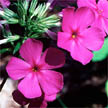 |
| |
|
One of the most astonishing displays occurs in August. It is then that the exotic spiderlily blooms at the edge of the oak slough. This three-foot-tall flower sends out palm-sized blooms with long, spidery tendrils. Another southern species, it is found only rarely in Indiana, in low-lying, wet wooded areas. Also in August, hikers will find the stately and bold red cardinal flower, along with stands of purple and white monkeyflower. In September, white snakeroot takes over part of the woods, and goldenrod and asters abound in the sunny field. But as the weather changes, the flowers quickly die off.
By October, there's very little in bloom and hikers are left
with fall foliage to enjoy. |
| |||
|
People who want to admire and learn the wildflowers of Twin Swamps can do so with the conventional, painstaking and often frustrating method of paging through field guides packed with a confusing jumble of pictures. These books cover broad geographical areas with many different habitats. They also toss a whole year's worth of flowers into one package, so a novice plant lover is obliged to sort through several hundred plants, most of which live somewhere else and bloom at another time. A hike through Twin Swamps shouldn't be so difficult. While more than a hundred types of flowers bloom throughout the year, only a few types of plants may actually be in bloom on any given day. A casual hiker in mid-May might notice only three or four different flowers. A more sharp-eyed and diligent observer might spot a dozen more. I hope this Web page will make the task of sorting out
wildflowers more enjoyable for the casual or beginning
nature-lover. If you look at the page before heading for the
swamp, you'll see that only a dozen or so flowers may be in
bloom at any given time in the different habitats. Or you
may return from the swamp in May, call up the Web page, and
see that phlox and penstemon were probably in bloom that
day. Flower lovers won't have to be frustrated by the
confusing and all-encompassing field guides. |
| |||
|
Mud, mud, mud. It's the first thing you notice on the Twin Swamps trail, and you'll also notice immediately when you get onto drier, more solid footing. You're not the only one. The plants notice, too. When the terrain rises, the soil tends to drain better and dry out faster. This firmer, drier ground supports plants that won't live in the muck. The trail map designates areas of the preserve as "low and wet," "low and dry," and "high and dry." The divisions between these areas are not well-defined, but you'll know when the habitat changes. You're either in muck or you're not. |
| |||
|
The change in elevation along the trail is subtle. There are a couple of spots where you might realize that you're on a slight slope, but you probably won't notice the difference if you're chatting with someone or watching a deer or a woodpecker. There are no hills that will make you feel as if you're climbing. The selection of plants in the low, mucky, water-soaked areas of the preserve is quite different from the selection in the higher, drier areas. |
|
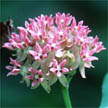 |
| |
|
Plants in the low, wet areas tend to be short, usually not more than a foot or two. But the well-drained, higher area supports plants that grow to six feet or more. By mid-summer you'll be pushing aside pokeweed to get through, so I've been calling this area the "pokeweed forest." The "low and dry" area is a bit odd because it's below the slope to the "pokeweed forest" but the ground tends to stay dry and firm. This region, roughly along the trail to the overcup oak slough, supports waist-high plants like yellow crownbeard and purple milkweed. It's here where the fantastic spiderlily is found in August. The other significant habitats at Twin Swamps are the
sunny field between the parking lot and the woods, and the
cypress swamp itself. Plant
life varies dramatically in both of these places. You might
consider the overcup
oak slough another habitat, but, frankly, I haven't
trekked around in there. |
| |||
|
The flowers at Twin Swamps tend to be distinguished by two major characteristics: where they grow and when they bloom. So I have tried as best I can to divide the plants by habitat and by season. Four "seasonal pages" will give you an idea of what plants you can expect to see in Early Spring (March-April), Late Spring (May-June), Summer (late June-July) and Late Summer (August-October). Each seasonal page is divided by habitat, so if you click on, say, the Summer page, you'll see a selection of plants that may be blooming in the low, wet area; a selection of plants from the sunny field; and another selection for the flowers of the cypress swamp. Please understand that some plants may bloom in more than one "season" and that in some years certain plants may bloom unusually early or late. I have also created "habitat" pages for the field; the low, wet woods; the low, dry woods; the high, dry woods; and the cypress swamp. These pages are further divided by season so you can see how the selection of plants changes throughout the year. If you glance at the trail map, you'll get a general idea of where the various habitats are found. I didn't try to define the areas precisely with borders because they tend to blend into each other and because they vary from year to year as the rainfall changes. A few plants are very adaptable. They may be found in
more than one habitat and in different seasons. For the most
part, though, the plants are surprisingly and conveniently
fussy. They tend to stay in their own neighborhoods, don't
move around a lot, and they bloom at predictable times. |
| |||
|
Parts of the Twin Swamps trail can be hard to hike because of the muck. You'll be tempted to wander into the woods a bit to find firmer ground, but please stay on the trail. Try to remember that Twin Swamps is a nature preserve, purposely created to save an unusual and diverse community of plants. Once people start to hike through the woods, others will follow and plants will be destroyed. My plant list includes only flowers that can be seen
easily from the trails or from the boardwalk. |
| |||
|
My main purpose in creating this Web site is to provide an easy flower guide for curious nature-lovers. But I hope others use it, too. Teachers at both the high school and college levels might use this site to prepare their classes for field trips to the swamp. I also hope that researchers in botany and other natural history fields will find the site useful. Entomologists, for example, might find value in knowing what host plants are blooming when. Note that a permit must be obtained from the Division of Nature Preserves in Indiana's Department of Natural Resources in order to collect any plants or to conduct research. I have tried to include every wildflower I see at Twin Swamps, but I know I have missed more than a few. Some plants have very small and inconspicuous flowers that are very hard to photograph. I will try to add these over time. I have not included a lot of trees, grasses or ferns, simply because I needed to limit the scope of my project. If you visit Twin Swamps and see any prominent wildflowers that are not included here, please let me know. I have included separate pages that show some of the mushrooms and other fungi, some birds, and some insects. These pages are not nearly as comprehensive as the flowering plants. I'd love to improve my bird photography, so if anyone wants to send me a 600 millimeter lens, please feel free. If anyone would like to contribute photos or information
on other plants and animals, please get in touch. |
| |||
|
Twin Swamps is a 500-acre wooded area, very close to the confluence of the Wabash and Ohio rivers in the extreme southwest corner of Indiana. A trail (see the trail map) leads visitors to two separate swamp areas, one dominated by bald cypress trees (Taxodium distichum) and the other dominated by overcup oak trees (Quercus lyrata). Twin Swamps is owned and maintained by the Indiana Department of Natural Resources. The DNR set the land aside in 1987 to ensure the survival of bald cypress trees in the state. These trees were once abundant along the river bottoms of southwestern Indiana, but their population has dwindled because of logging, farming, and especially the damming of the Ohio River for navigational purposes. The remains of a large stand of cypress trees can be seen at Hovey Lake, which is about two miles southeast of Twin Swamps. However, the nearby river dam has raised the level of the lake, permanently inundating the trees and threatening their survival. Twin Swamps represents an ecological region known as the
Southern Bottomlands of Indiana. This region, which hugs the
lower Wabash and Ohio rivers, has the state's longest
growing period. Temperatures, rainfall and humidity are
high; winters are mild. Because of this, Twin Swamps has
several plants and animals that are characteristic of the
southern United States and which reach their northern limit
in Posey County. |
| |||
|
Twin Swamps Nature Preserve is 10 miles southwest of Mount Vernon, Indiana, if you're a crow. It's a bit longer by car. If you need gas or food, you'll have to get it in Mount Vernon. Take Indiana 62 west from Mount Vernon to Indiana 69. (Go
2.7 miles from the courthouse square in Mount Vernon to
Indiana 69.) A trail leads from the parking lot to the woods, where the swamp is found. (See the trail map.) The shortcut is easier to find when you leave the
swamp: If you want to take the shortcut to get to the swamp, do
this: This route saves you two miles, but it doesn't go near Hovey Lake or the dam, which are important to know about, because ... Twin Swamps Nature Preserve has no amenities. There are no toilets and no drinking water. Toilets may be found at Hovey Lake and at the John T. Myers Dam, both about two miles away. Both places have picnic areas. Hovey Lake offers boating and fishing, and is operated by the Indiana DNR. The Myers Dam can be interesting for kids because big river barges are frequently seen "locking through" the dam. All that you'll find at Twin Swamps is a muddy trail through the woods. The trail from the parking lot to the cypress swamp is about one mile long but it will probably seem longer if the trail is wet. And it usually is, especially in the spring. (Here's another chance to look at the trail map.) On a hot summer day, the mosquitos will be glad to see you. Some lengths of boardwalk have been placed to make the hike easier, but in many places you may be slogging through very wet mud. Some parts of the trail may be flooded. Wear waterproof boots. A very nice boardwalk extends into the cypress swamp and is a great place to relax, enjoy the surroundings, listen to the birds and frogs. You're likely to spot warblers or great blue herons. Be aware that the trails are NOT well-marked. A few yellow-tipped stakes show the way, but they're few and far between. In the summer, the trail is easy to see because it is bordered by lush foliage. In the fall and winter, when the foliage is gone and dead leaves have fallen, the trail will be very difficult to follow.
|
| |||
|
On my trips to the swamp, I carry about 25 pounds of camera gear, including two Nikon camera bodies (manual-focus -- an FE and an EM), two or three lenses (a Nikon 28-85 mm, a Nikkor 200 mm, and sometimes a Tokina 400 mm for birds), a sturdy Bogen tripod, and a flash. I bring two camera bodies so I can use two types of film. Most of my pictures have been taken with Fuji Velvia, a slow, 50-speed slide film that provides superior color saturation and clarity. I've recently found an acceptable 200-speed film, E200 by Kodak, that produces very good color and acceptable resolution. The E200 is not as sharp as the Velvia, but the faster film lets me shoot in a slight breeze, something that's impossible with Velvia. Velvia forces me to use slow shutter speeds, generally from 1/15th-second to 1/4-second. Occasionally, my exposures will be 1 or 2 seconds or more. I always shoot from a tripod and, in order to minimize camera vibration, I use a cable release to trigger the shutter. I use some close-up devices, especially extension tubes, to help me focus closer to the subject and produce a larger image. As I move closer to the subject, however, the effect of even the slightest breeze becomes more noticeable, and I often have to wait many minutes for a flower to stop bobbing before I can snap the picture. Depending on my frame of mind, this can be very meditative. Or it can drive me crazy. I use my flash only if the breeze is persistent or if the natural light is very poor. The flash tends to produce an artificial appearance that alters the color of the plants, so I prefer to rely on natural sunlight. I bracket my exposures, taking some pictures at the
automatic setting selected by the camera and some at
slightly slower or faster settings. To produce one
acceptable photo, I may take anywhere from three to thirty
exposures. On average, I probably take about ten shots of
each plant. Sometimes, of course, I need to return to the
swamp to take more shots if my first efforts have a problem
with focus or exposure. (A few of the photos included here
obviously leave something to be desired. Frankly, it's been
tricky to get satisfactory shots of so many plants.) |
| |||
|
Identifying all of these plants has been quite a learning experience. With the help of Dr. Scott Gordon, a biology professor at the University of Southern Indiana, I obtained a provisional plant collection permit from the Division of Nature Preserves in the Indiana DNR. This allowed me to take specimens of the more difficult plants to a lab at USI, where I used a dissecting microscope to examine all their little parts. I learned a whole new vocabulary (stipules and stipes, puberulent and glabrous). I relied on several reference works to "key down" my plants and identify them by species. Most valuable were Charles Deam's Flora of Indiana, Robert Mohlenbrock's Guide to the Vascular Flora of Illinois, Britton and Brown's An Illustrated Flora of the Northern United States and Canada, and Mary Wharton's A Guide to the Wildflowers and Ferns of Kentucky. I can't begin to express my admiration for the exhaustive work performed by these botanists. I followed the scientific nomenclature in Mohlenbrock, which is the most recent of the works I used. The "range" information given with each plant comes from Deam, which was published in 1940, and from Britton and Brown, which dates to 1915. Some of that information may be out of date. I'll be amazed if I didn't goof up somewhere along the line. Please let me know if you spot an error in my identifications. My e-mail address is rick.mark1217@gmail.com All collected plants were dried and mounted and added to
the USI herbarium. |
| |||
|
Thank you for exploring my Web site. My name is Rick Mark. I'm a newspaper editor and amateur photographer and nature-lover. I live in New Harmony, Indiana, which is a quaint and historic town on the Wabash River. This Web site evolved from my work in a graduate program at the University of Southern Indiana in Evansville. The Master of Arts in Liberal Studies program is an interdisciplinary course that concentrates on English and history, with ties to sociology, psychology, and science. The program culminates with a "capstone project," which is a project of some substance, not necessarily a research paper, that is roughly equivalent to a traditional master's thesis. For my project, I decided to combine my interest in photography with the thing I love to do most, which is walk in the woods. So I set out to photograph all of the wildflowers that bloom at Twin Swamps. Originally, I thought I would give a slide presentation and a talk and that would be my capstone. But then I described my project to a botany professor at another college. Dr. Eric Ribbens at the University of Evansville lamented, kindly, that if I present my work to the people at USI, that will be the end of it. How could others make use of the project, he wondered. He suggested that I put it on the Web. I hope you find this Web site useful. I know I've fallen short of my goal of photographing "every" wildflower at the preserve. The more plants I learn, the more I see. I look forward to hearing from people who use this site. If you have suggestions on how to improve it, please write to me at rick.mark1217@gmail.com This Web site could not have been created without the help and encouragement of many people. Professors and administrators at the University of Southern Indiana were very supportive. I especially want to thank Dr. Scott Gordon of the Biology Department for his enthusiasm and interest in the project. He's been my botany mentor and he took great pains to help me find the resources and the space I needed. He even let me share his office for many weeks, much longer, I'm sure, than he expected. Thanks also to Dr. Eric McCloud, who was always available for valuable consultation, and to Dr. Paul Doss for filling me in on the leptothrix, which is very cool. And thanks to Drs. Tom Rivers and Tom Wilhelmus in the Liberal Studies program for their encouragement and support. The people at the Indiana Department of Natural Resources' Division of Nature Preserve were very helpful, especially botanist Mike Homoya. Our e-mail exchanges have been invaluable. The DNR provided me with a provisional plant collection permit, which helped me identify many of the more difficult plants. The Indiana Academy of Science supported my project with a grant that helped me cover the costs of film and travel. Thanks also to Sally Roth and our son, David, who are my
biggest supporters. When all else failed, I could always
turn to them for help. Sally's encyclopedic knowledge of
plant life is unparalleled, and she's been my number one
resource. More than that, she's helped me learn to see.
David, thanks for coming along on muddy swamp trips and for
helping with the map and for providing another shoulder to
lug all that heavy camera gear. |
| |||
|
|
|
These birds have been seen or heard at Twin Swamps by me and my family. | ||
|
|
|
|
|
Blackbird, red-winged |
Hawk, red-shouldered |
Thrush, wood |
|
| ||
|
and other interesting pages |
|
Wildflowers
of Western Kentucky Indiana
DNR Division of Nature Preserves Guide to
Hoosier Natural Areas Southern
Illinois University Herbarium
Biography
of Charles Deam Vascular
Plant Image Gallery Wildflowers
of North Carolina Grass
images New
Harmony Scientists, Educators, Writers and
Artists I occasionally call up a search engine and do a search for <wildflowers and photographs>. I get thousands of hits and find wonderful photos of beautiful plants found around the world. Try it. |
|
|
|
|
|